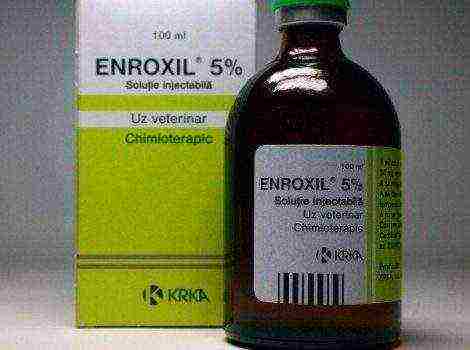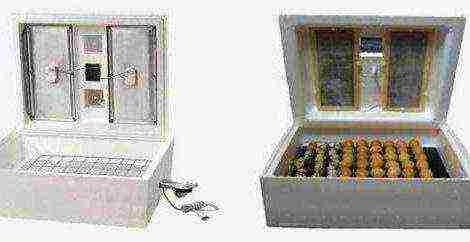Content
- 1 Breeding and raising ducks at home for beginners
- 1.1 How to breed and raise ducklings for beginners?
- 1.1.1 Raising and breeding ducklings hen
- 1.1.2 How can you raise ducklings in an incubator and how long does it take?
- 1.1.3 Proper maintenance and care
- 1.1.4 How to feed ducklings: compound feed, mash and vitamins with your own hands
- 1.1.5 Feeding in the first days of life
- 1.1.6 What food should be given to individuals from one to three weeks?
- 1.1.7 How should ducks be fed from one month of age to slaughter?
- 1.2 How to keep adult ducks at home?
- 1.1 How to breed and raise ducklings for beginners?
Breeding and raising ducks at home for beginners
Duck is a fairly common poultry in a rural backyard. It can often be found in rural areas, especially if there is a body of water there. Ducks are raised for meat. By the age of one month, young animals weigh up to 2.5 kg. An adult drake weighs about 4 kg. In addition, ducks lay up to 120 eggs throughout the year.
In this article, we will talk about breeding and raising ducks at home for beginners. In addition, we will learn how to properly feed ducklings at home, what kind of mash, compound feed, what is their composition.
How to breed and raise ducklings for beginners?
Keeping ducks at home for beginners is not much different from raising chickens or geese. But, there are some nuances that should be considered when breeding this bird. You should definitely dwell on them in more detail. Including how long ducks live.
Raising and breeding ducklings hen
An interesting point is that duck eggs can be placed under a chicken or turkey, and they will hatch eggs, mistaking them for their own. But a duck or goose is unlikely to want to do the same with other people's eggs. So, any of three poultry is chosen as a brood hen - chicken, duck or turkey. Of course, it's better if it's a duck.
Up to 15 eggs are usually placed under the duck if the brood is planned to be obtained in the summer and up to 12 if in the spring. This is due to the ambient temperature. Naturally, more eggs are placed under the turkey, which is explained by its large size, and less under the chicken. The main thing is that all eggs in the clutch are under the hen in order to evenly heat them by the body of the hen.
For the hen, a wreath-shaped nest is made of straw so that the eggs do not roll in different directions. The hen will add the rest of the components (for example, feathers). On the bottom of the nest, if it is located on the floor, put sawdust and chaff.
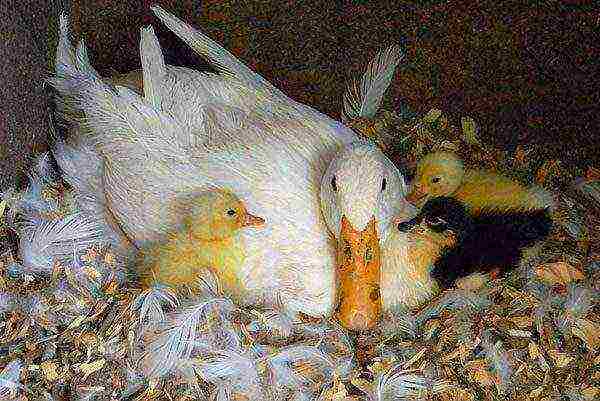
It is best to make the nest on a small hill and away from direct sunlight, in the darkest part of the house. There is no need to artificially shade this place. If it seems uncomfortable to you, make an impromptu partition. This will separate one nest from the other and create a feeling of extra comfort.
The first brood is obtained as early as 27 days after the start of incubation.
All chicks should hatch in 1 to 2 days. So that the hen does not overwhelm them, the ducklings are taken to a separate box immediately after birth. To do this, you can take a cardboard box lined with straw and a floor. The normal temperature for them at this time is 30 degrees. Therefore, if the brood turned out in spring, take care of an additional source of heat.
After all the ducklings are born, they are returned to the hen - the duck. Better to do this in the evening. Make sure that the mother duck accepts them, as chicks especially need warmth during this period.
How can you raise ducklings in an incubator and how long does it take?
The main advantage of raising ducklings in an incubator is the ability to get a brood at any time convenient for you. In addition, there is no need to take care of the hen, and the incubator can be made with your own hands. Modern home incubators are equipped with temperature and humidity controls. Therefore, you just have to monitor the process, turn the eggs over (if this is not provided automatically by the design of the incubator) and occasionally open the apparatus for their small short-term cooling and to remove accumulated gases.
Before laying, the incubator is heated, setting the temperature 1-2 degrees higher than necessary for incubating eggs at the very beginning of the process. Besides, it is recommended to make high air humidity. For this, several trays of water are installed on the pallet.
Due to the fact that the shell of duck eggs is stronger than chicken and they are larger in size, somewhat different in chemical composition, the brood appears later.
In the first week after laying, the temperature in the incubator should be at 38 degrees (the first 3 days - 38.2, the next 4 - 37.8). Humidity is required to be kept at 60%. After two weeks of eggs in the incubator, it is worth opening the incubator door for 30 minutes twice a day, reducing the temperature to 32 degrees. Then the temperature regime is resumed.
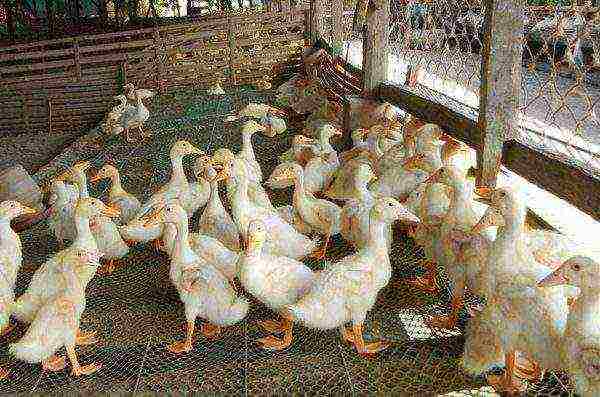
If you have an ovoscope, you need to check the eggs for embryos after 9-10 days. A sharp drop in air temperature must not be allowed. Chicks hatch on the 27-28th day within one or two days. Air humidity is maintained at 55%. After the chicks are dry, they are transferred to a box, basket, box, after putting dry sawdust, chaff, and straw on the bottom.
Proper maintenance and care
In the first 20 days of life, ducklings need increased attention in relation to compliance with the temperature regime. If they are near the duck, you should not worry about an additional source of heating - the duck itself is able to protect them from low temperatures. In the first week of life, the temperature should be maintained at the litter level of 27-30 degrees; in the second week - 23-26, in the third - 19-22. Then they get used to the natural air temperature.
As said before, the litter must be dry. Otherwise, the ducklings freeze and get sick.
The duration of daylight hours at the beginning of life should be at the level of 20 hours with a gradual decrease to 12 hours at one month of age.
Ducklings with a duck are allowed to walk in the morning and afternoon after five days of age. In the evening, they are closed in a room with additional heating if the air temperature is below the above marks. And after three weeks of age, you can even leave them outside the room around the clock.
The presence of a reservoir is very good for raising ducklings. With an adult bird, they are released into the water after three weeks of life. Independently - after a month. You can keep ducklings in cages for the first two weeks. Then they are given more freedom. That is, partly to walk. Monthly young growth is transferred entirely to the content of the walk.
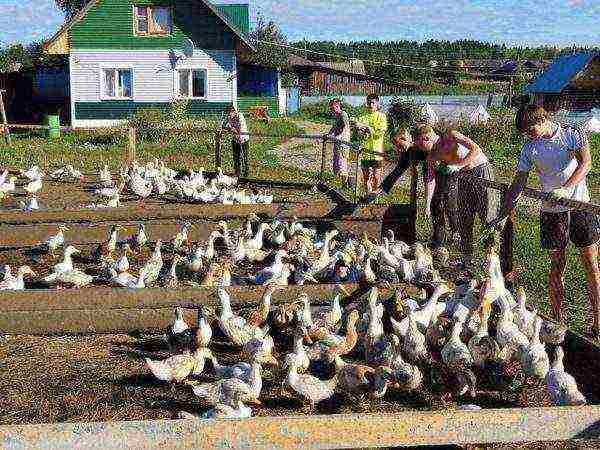
How to feed ducklings: compound feed, mash and vitamins with your own hands
Feeding ducklings at home for beginners is simple. Youngsters quickly get used to receiving food at the same time. Therefore, you do not have to teach them in addition to a specific diet. Ducklings grow and gain weight quickly. At three weeks of age, he weighs about half a kilogram, after six weeks his weight is on average one and a half kilograms, and at 2.5 months he can already be slaughtered, since his weight reaches two and a half kilograms.
But it is better to slaughter them before the onset of frost, since in summer and autumn, the main diet of ducks is greens and everything that they themselves find on the pond. That is, you have to spend little on food.
You may also be interested in useful articles:
- All about incubating duck eggs at home.
- How to raise broiler ducks at home.
- How to breed Peking ducks on your farm.
- Description, characteristics and advantages of Agidel ducks.
Feeding in the first days of life
Feeding ducks at home in the first week occurs 6-8 times during the day. A schedule can be made so that the first feed is early in the morning and the last before dusk. Finely crumbled boiled eggs, low-fat cottage cheese, and other milk-based products are the main diet of ducklings during this period.
It is advisable to give food from narrow troughs, since wide dishes in the form of a brazier contribute to the fact that the ducklings simply trample the bulk of the food. Drinking bowls should not be placed next to food, as the latter quickly becomes wet and the water dirty.
The fact is that a duck is a waterfowl. At a very young age, she manifests an instinct to eat food, either in the water, or to drink it directly after it enters the beak. Thus, if you put the drinker away from food, the duckling, until it reaches the drinker after eating, will already swallow the bulk of it. In this way, clean water can be kept. By the way, it is recommended to dilute a little potassium permanganate in it, but in such a dosage that it cannot turn the water pink.
After five days, begin to prepare mash for ducklings from the above products with the addition of ground corn and wheat skins.
What food should be given to individuals from one to three weeks?
How to feed small ducks at home? After a week of life, the ducklings are accustomed to greens, because in the future it will become the main food in the diet of these birds. At this age, the duckling eats about 40 grams of various foods. Gradually reduces the proportion of boiled eggs and dairy products, replacing them with large portions of wheat and corn skins. The diet is supplemented with animal feed: fish and meat and bone meal.
By the age of two weeks, the duckling needs about 60 grams per head. By this period, boiled eggs, cottage cheese and other dairy products are completely excluded from the diet. More greenery is given instead. Ideally, if it is duckweed. This bird eats it with pleasure in almost unlimited quantities. At the same time, intensive growth and mass gain begins.
It should not be forgotten that a growing duck eats significantly less. After 20 days of age, the ducklings are released into the pond together with the mother duck.
You can use "dry" feeding, in which the main diet will be purchased compound feed for ducklings. In this case, growing them will be more expensive, but ducklings grow faster.
How should ducks be fed from one month of age to slaughter?
How to feed ducks at home in a month? Grinding of various grain crops, millet, meat and bone and fish meal, shells, chalk, sunflower meal, fodder yeast and greens - these are the components that make up the diet of young animals during this period of life.
In addition, grazing them on a pond will diversify food and reduce the cost of maintenance by about 2 times. The total part of the grass in the diet is 40%, greens - 30%. If a duck has the ability to eat duckweed, then the component of greens in the diet increases by one and a half times.
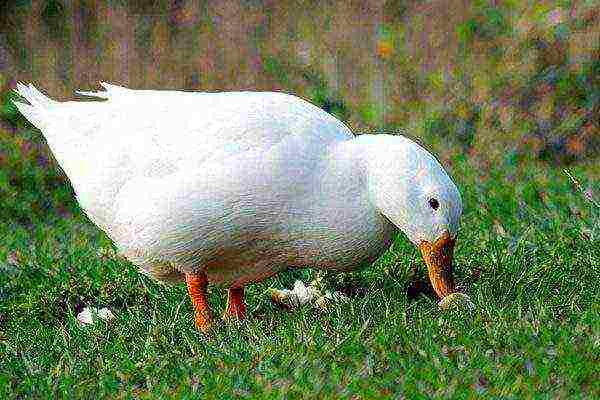
How to keep adult ducks at home?
An adult duck (drake), depending on the breed, can weigh from three to four kilograms.The most common breeds of meat duck breeds.
- Beijing: grows and gains weight quickly, tolerates winter well. Two-month-old young animals have a live weight of about 2.5 kg. An adult duck - up to 3.5 kg, and a drake - up to 4 kg. Egg production - up to 110 eggs per year. The meat is delicious.
- Bashkir color: the meat is of excellent quality, adapts well to new conditions of keeping, the fat content is low. Productivity is high.
- Black white-breasted: the weight of an adult duck is 3-3.5 kg, a drake is up to 4 kg. The meat is delicious. A distinctive feature of this breed is increased egg production - up to 130-140 eggs per year.
- Moscow White: the weight is the same as that of the black white-breasted. The meat is very tender and tasty. Egg production is high - up to 160 pieces per year.
- Gray Ukrainian: live weight of drakes is 3-3.5 kg. Weft - up to 3 kg. Egg production is very high and sometimes reaches 220 pieces per year.
Among the meat, egg and egg breeds, the following can be noted.
- Khaki Campbell - meat and egg breed of ducks. Differs in a calm character. Average egg weight - 75 g, egg production - up to 330 pieces. Drake weight - up to 3 kg, ducks - up to 2.5 kg.
- Indian runner - egg breed. It got its name from its high mobility. Egg production and weight similar to Khaki-Campbell. The meat tastes like chicken.
To decide on the choice of the breed, you need to decide for yourself for what purposes you undertake to breed them. Meat breeds weigh more, egg production is less, in meat-egg and egg breeds - on the contrary. White and French ducks are also good for growing.
The ducks are kept indoors or outdoors. In the first case, they should feed more intensively due to compound feed and low mobility of the bird.
The room should be well ventilated, moderately light and warm. An adult duck tolerates winter well, but it is better that the indoor temperature during this period does not drop below 5 degrees Celsius. For 1 sq. m of the area are bred 4 ducks.
Walking way for this bird is better. But it depends on the ability to do such a walk and the presence of a reservoir. In this case, it is better to split the livestock into small groups - 10-15 heads each, dividing them with low partitions. Of the reservoirs, shallow rivers and lakes are preferred. The walks are fenced off with a low fence. They can be made adjacent to the poultry houses so that ducks can hide in a covered area if they wish.
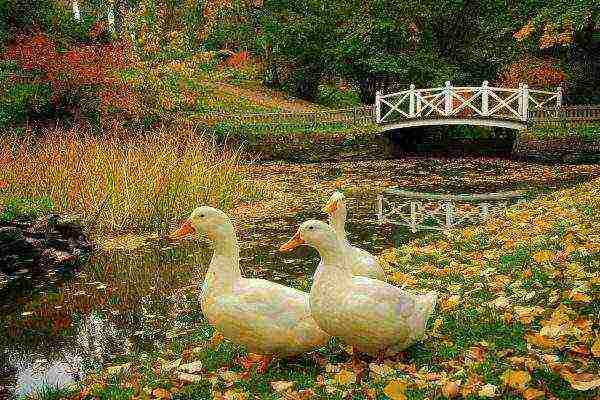
The feed is the same as for the young. Emphasis is placed on the grains of cereals and corn, with more corn in the composition. Do not give ducks bread crumb, which negatively affects the digestive system of the bird.
It is also forbidden to give not fresh mash. In general, if there is a suspicion about the quality of the feed, it is better to refrain from feeding it to the bird. Do not forget to give green mass or release it for walking in the pasture, if there is no reservoir nearby. If there are nearby rates or a lake - drive them there. On it, ducks will find the bulk of their food.
If you feed the ducks with non-purchased compound feed, then their composition may be as follows:
- 40% of rubbing a mixture of grain crops, of which at least half is corn;
- 30% green mass;
- 10% grain waste;
- 7% cake and meal;
- 7% animal feed;
- 6% shells, chalk, feed yeast, vitamins, mineral supplements, etc.
It is very important to give vitamins to ducklings and adult ducks, especially in the autumn-winter and winter-spring period, when there is not enough sunlight and there is no greenery at all. If it is problematic to buy vitamins, you can use brewer's yeast, which contain a lot of proteins, carbohydrates and fiber.
Breeding ducks is no big deal. The main thing at the initial stage of their cultivation is to be attentive to the feeding processes, to give balanced food and to find a place for them to walk and a reservoir for them. Then not only will your family have tender and tasty meat, but you will also be able to cover the costs of keeping this bird with interest by selling surplus products.
